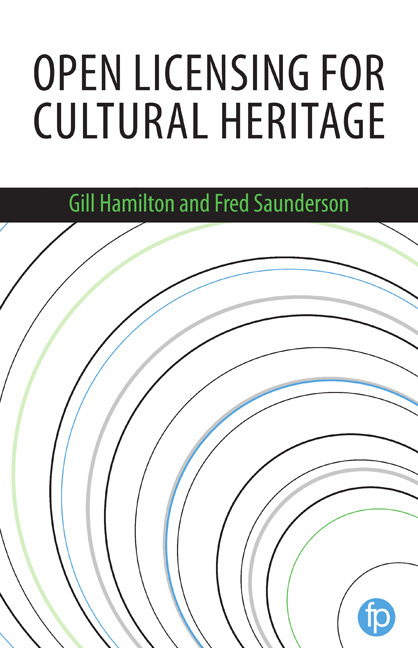Book contents
- Frontmatter
- Contents
- List of figures and tables
- Acknowledgements
- About the authors
- 1 Introduction
- 2 The open movement: its history and development
- 3 Copyright and licensing: a background
- 4 Open licensing: the logical option for cultural heritage
- Introduction to case studies
- 5 Small steps, big impact – how SMK became SMK Open
- 6 The British Library experience of open metadata licensing
- 7 Open policy and collaboration with Wikimedia at the National Library of Wales
- 8 Newcastle Libraries – the public library as a place to share culture
- 9 Developing open licensing at the National Library of Scotland
- 10 The Wellcome Library
- 11 Developing an open educational resources policy and open approaches to mitigate risk at University of Edinburgh
- 12 How to implement open licensing
- 13 Using and reusing openly licensed resources
- 14 Conclusion
- Index
4 - Open licensing: the logical option for cultural heritage
Published online by Cambridge University Press: 08 June 2018
- Frontmatter
- Contents
- List of figures and tables
- Acknowledgements
- About the authors
- 1 Introduction
- 2 The open movement: its history and development
- 3 Copyright and licensing: a background
- 4 Open licensing: the logical option for cultural heritage
- Introduction to case studies
- 5 Small steps, big impact – how SMK became SMK Open
- 6 The British Library experience of open metadata licensing
- 7 Open policy and collaboration with Wikimedia at the National Library of Wales
- 8 Newcastle Libraries – the public library as a place to share culture
- 9 Developing open licensing at the National Library of Scotland
- 10 The Wellcome Library
- 11 Developing an open educational resources policy and open approaches to mitigate risk at University of Edinburgh
- 12 How to implement open licensing
- 13 Using and reusing openly licensed resources
- 14 Conclusion
- Index
Summary
Introduction
In this chapter we suggest that an open approach to licensing in cultural heritage should be developed. Building on the developments in the open movement and the realities of intellectual property rights set out earlier in this book, we argue that there should be openness in the sector. We describe why organisations should consider being open, looking in detail at both the core benefits and potential risks of an open approach.
Acting with purpose: why are you making digital collections available?
Digital raison d’être
Informed and logical decision making should guide the work of cultural institutions. A visitor to an exhibition of abstract art might expect to see works there by Piet Mondrian. Conversely, if the art of J. M. W. Turner was included it would appear out of place and visitors would reasonably question the decision making and structure behind the show.
The need to act with purpose is equally present in the newer, less tangible, and more fluid realms in which cultural heritage organisations are increasingly operating. If an art gallery intends to undertake a digitisation project, it is reasonable to expect that staff make informed decisions about what material will be captured, to what quality standards, and in what format images will be retained. A gallery preparing a digital exhibition on abstract art may seek to digitise works by Mondrian. It may be questionable for the gallery to use the launch of an abstract art exhibition to digitise works by Turner.
Cultural and information organisations need to make logical, strategic and sustainable decisions before, during and after digital capture, considering why material should be captured, how it will be managed before and after capture, and who it is being captured for. In short, organisations need to consider their digital raison d’être.
Strategy
The 2013 Enumerate study of nearly 1400 European cultural heritage institutions found that most (87%) had a digital collection. However, only around a third (36%) of the institutions had a distinct digitisation policy. Slightly fewer (34%) of the organisations actually had an explicit policy for the use of their digital collections. These figures indicate that while maintaining digital collections is common and increasingly common, only about one-third of institutions have dedicated policies on digitisation.
- Type
- Chapter
- Information
- Open Licensing for Cultural Heritage , pp. 65 - 94Publisher: FacetPrint publication year: 2017



